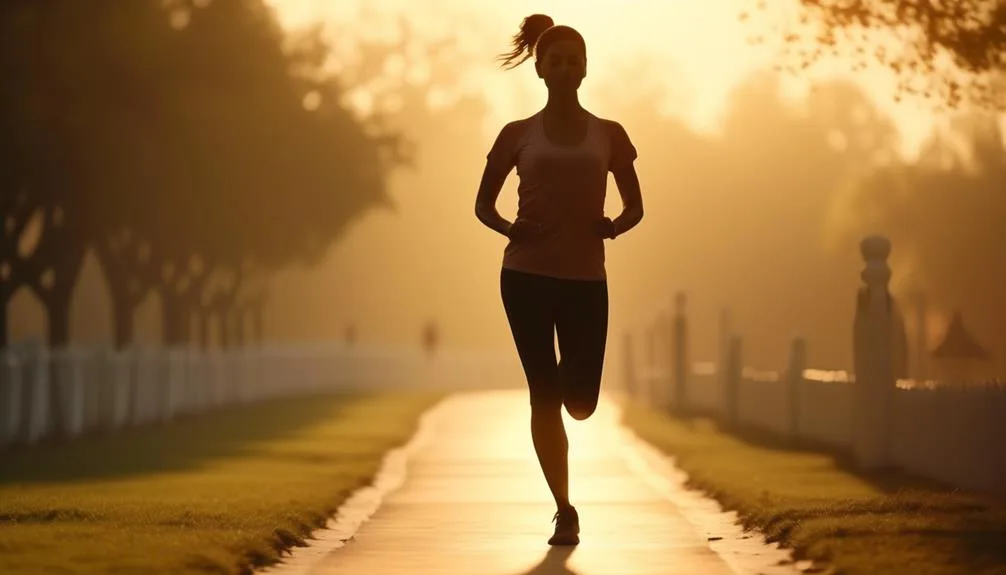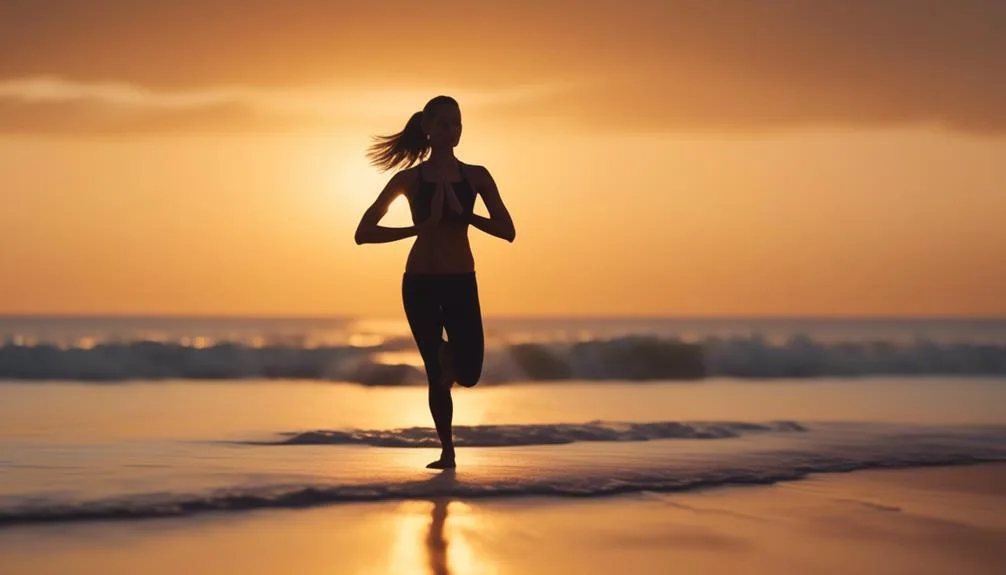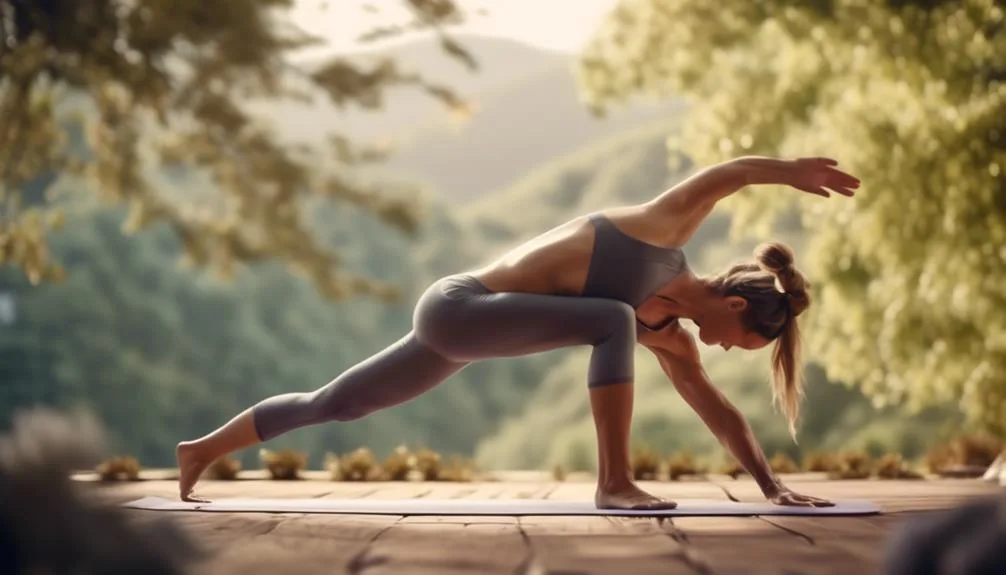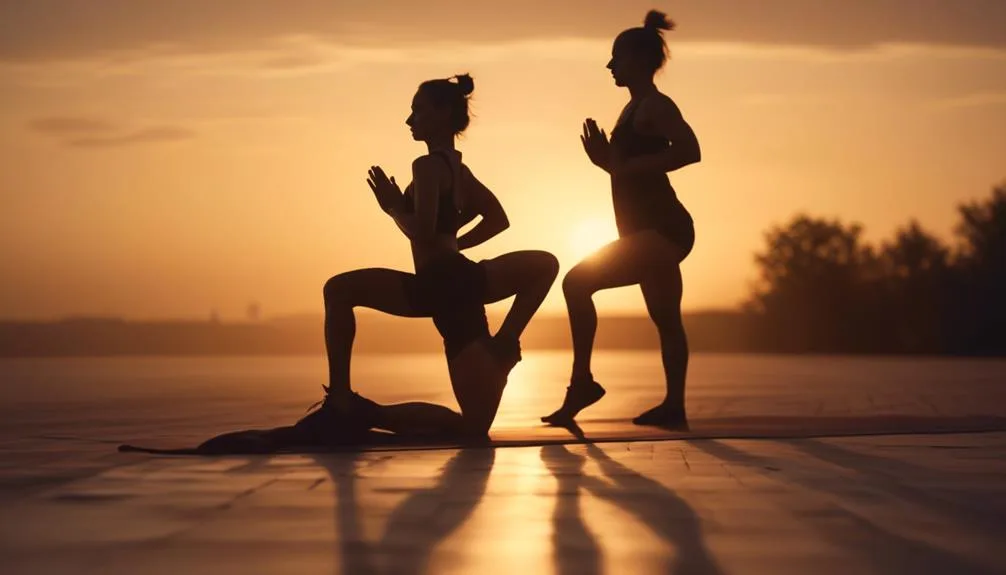Unlock the Power of Yoga for Runners
As a runner, you tread the tightrope between pushing your limits and respecting your body's need for recovery. Imagine weaving the ancient practice of yoga into your running routine, not just as an afterthought but as a cornerstone of your training. You'll not only stretch but also strengthen muscles you didn't know were essential for your runs. By incorporating yoga, you're signing up for a journey that promises reduced injury risk, enhanced flexibility, and a stronger core, all of which can elevate your running performance to new heights.
This isn't merely about touching your toes or mastering a pose; it's about embracing a holistic practice that harmonizes body and mind, preparing you for the miles ahead. So, why not explore how yoga can be your secret weapon on the track or trail? The benefits you'll uncover may just transform your approach to running and overall well-being.
Key Takeaways
- Incorporating yoga into your warm-up and cool-down routine can activate inactive muscles, condition the core, loosen up muscles before a run, prevent running injuries, and improve flexibility and range of motion.
- Restorative yoga is important for runners as it reduces soreness, prevents over-training-related injuries, promotes sleep and recovery, focuses on calmness and deep stretching, and complements more active styles of yoga.
- The best time to do yoga for runners is in the morning, as it helps build momentum. However, evening sessions can focus on reflection and mindfulness. Yoga can be done before or after running, as long as there is enough time between the two activities.
- Specific yoga poses like Reclined Quadriceps Stretch, Half Split, Pigeon, Lizard, and Wide-legged Forward Fold can target different areas of the body, relieve tightness, reduce soreness, speed up recovery, and improve overall flexibility and strength for runners.
Yoga Warm-Up Benefits
Incorporating yoga into your warm-up routine activates dormant muscles, preparing your body for a run with improved flexibility and a lower risk of injury. The benefits of incorporating yoga into a runner's routine are vast.
It not only conditions your core, essential for stability and endurance, but also loosens up muscles, ensuring you're limber and less prone to strains or sprains. How yoga improves performance and prevents injuries in runners isn't just theory; it's grounded in the practice of awakening every part of your body before you hit the ground running.
Embracing yoga means you're not just running smarter, but you're safeguarding your body against shin splints, runner's knee, and other common ailments. Let yoga be the secret weapon in your running arsenal.
Preventing Running Injuries

To prevent common running injuries like shin splints and IT band pain, integrating yoga into your routine is a game-changer. The benefits of yoga for runners are immense, activating muscles that often remain dormant, conditioning the core, and significantly enhancing flexibility. This means not only a lower risk of injuries but also improved performance.
Here's a tip: start with as little as 10 minutes of yoga post-run, focusing on poses that target your problem areas. Incorporate poses like the Pigeon for your hips and the Reclined Quadriceps Stretch for your knees. Gradually, make yoga a non-negotiable part of your cool-down routine.
Restorative Yoga Essentials

Exploring the essentials of restorative yoga can significantly enhance your running recovery and overall performance. Delving into restorative yoga benefits and techniques, you'll find peace and rejuvenation for both mind and body. It's not just about stretching; it's about deeply connecting with yourself, promoting recovery, and preventing injuries.
| Restorative Yoga Benefits | Restorative Yoga Techniques |
|---|---|
| Reduces soreness & aids recovery | Gentle, supported poses |
| Prevents injuries by promoting flexibility | Mindful breathing exercises |
| Enhances sleep & recovery | Use of props for deeper relaxation |
| Soothes and revitalizes the nervous system | Focused, calm, and deep stretching |
Embrace these techniques to unlock a stronger, more resilient runner within you. Let restorative yoga be your secret weapon in achieving peak performance.
Optimal Yoga Timing

After understanding the essentials of restorative yoga and its benefits for your running regimen, it's crucial to consider when to best integrate yoga into your daily routine for maximum effect. Incorporating yoga for cross-training enhances your performance by activating muscles that are often neglected during runs.
The benefits of yoga before running are significant; it conditions your core, loosens up muscles, and prevents common running injuries by improving flexibility and range of motion.
For optimal timing, practice yoga in the morning to build momentum for the day ahead. Alternatively, evening sessions can focus on reflection and mindfulness, aiding in recovery. Whether you choose morning or evening, ensure yoga sessions are spaced apart from runs to prevent overtraining and maximize the benefits.
Key Yoga Poses Explained

Delving into key yoga poses, let's start with how each can specifically aid your running performance, focusing on muscle activation, injury prevention, and recovery.
Yoga for runners: key poses like the Reclined Quadriceps Stretch and Lizard pose are crucial.
The Reclined Quadriceps Stretch is a game-changer for preventing knee injuries and relieving tightness in your thighs, essential for runners aiming for endurance and speed.
Meanwhile, the Lizard pose targets your hip flexors, a common area of tightness for many runners. This deep stretch not only enhances your flexibility but also aids in recovery, allowing you to return to running with more ease and less discomfort.
Incorporate these poses into your routine to unlock their full potential.
Stretching Post-Run

Having covered key yoga poses for runners, let's focus on the crucial step of stretching after your run to enhance recovery and prevent injuries. Post-run recovery is essential, and targeted muscle stretching can significantly improve your flexibility and reduce the risk of injury. Here's a quick guide to stretches that target key areas for runners:
| Pose | Targeted Muscles |
|---|---|
| Reclined Quadriceps Stretch | Quadriceps, Knees |
| Half Split | Hamstrings, Calves |
| Pigeon | Glutes, Lower Back |
| Lizard | Hip Flexors, Hips |
Incorporate these stretches into your routine to ensure a comprehensive post-run recovery. Each stretch targets essential muscles used during running, promoting flexibility, alleviating tightness, and preparing your body for your next run. Keep it up, and watch your performance soar!
Frequently Asked Questions
How Does Incorporating Yoga Into My Running Routine Impact My Mental Health and Focus During Runs?
Incorporating yoga into your running routine boosts your mental health and sharpens your focus. You'll experience mindfulness benefits and stress reduction, making each run more enjoyable and mentally rewarding. It's a game-changer for your mind.
Can Yoga Help Improve My Running Speed and Endurance Over Time?
Absolutely, yoga can boost your running speed and endurance by increasing flexibility and preventing injuries. It strengthens and stretches key muscles, enhancing your performance and enabling you to push further with less risk of harm.
Are There Specific Yoga Poses That Can Help Enhance Lung Capacity and Breathing for Runners?
Yes, certain yoga poses enhance lung capacity and breathing for runners. Incorporating breath control techniques and flexibility benefits, these poses improve your endurance and speed. It's about deepening your breath and stretching your limits!
How Do I Modify Yoga Poses if I'm Dealing With an Existing Running Injury?
If you're nursing a running injury, modify yoga poses for injury prevention and flexibility training. Focus on gentle stretches and use props for support. Listen to your body and avoid deep stretches in painful areas.
What Are the Nutritional Considerations for Runners Practicing Yoga to Ensure Optimal Performance and Recovery?
To ensure optimal performance and recovery, you'll need to focus on hydration strategies and protein intake. Drink plenty of water and eat protein-rich foods to repair muscles and stay energized for your runs.
Conclusion
As you lace up for your next run, remember the power of yoga isn't just a stretch; it's your secret weapon.
By seamlessly integrating yoga into your routine, you're not just running; you're soaring beyond limits.
Embrace those key poses, optimize your timing, and watch as injuries fade and performance peaks.
Let yoga be the bridge to your untapped potential, transforming each stride into a journey of discovery.
Run, stretch, recover, and repeat.
The path to your best run starts here.






